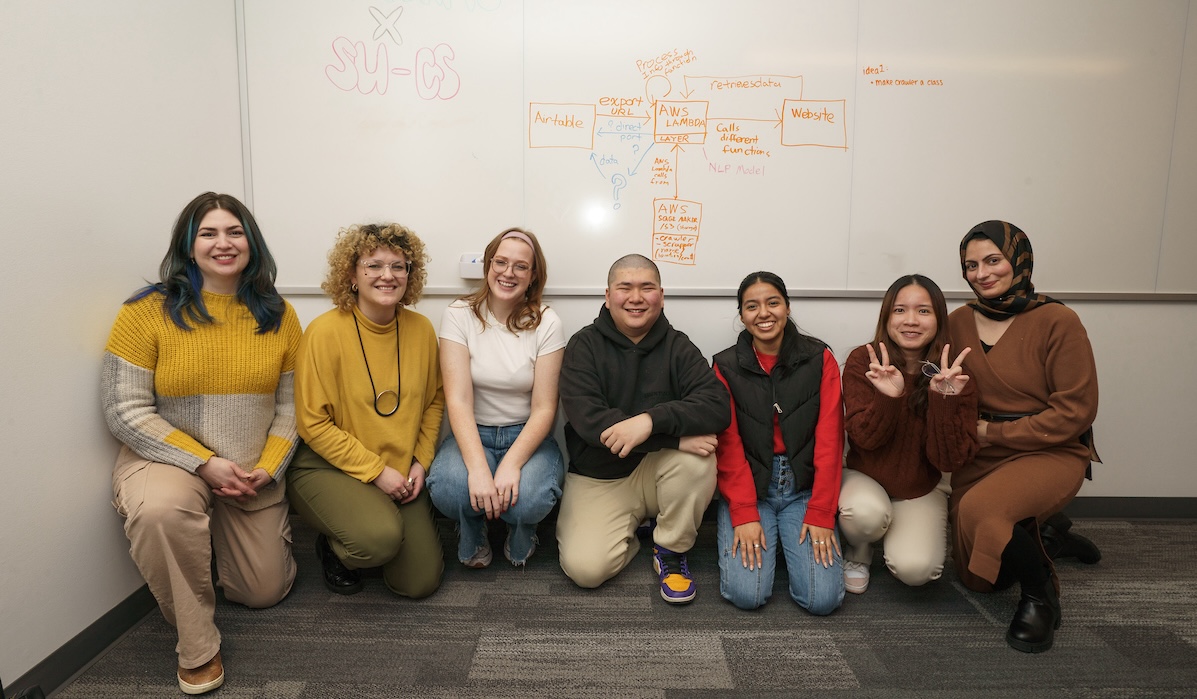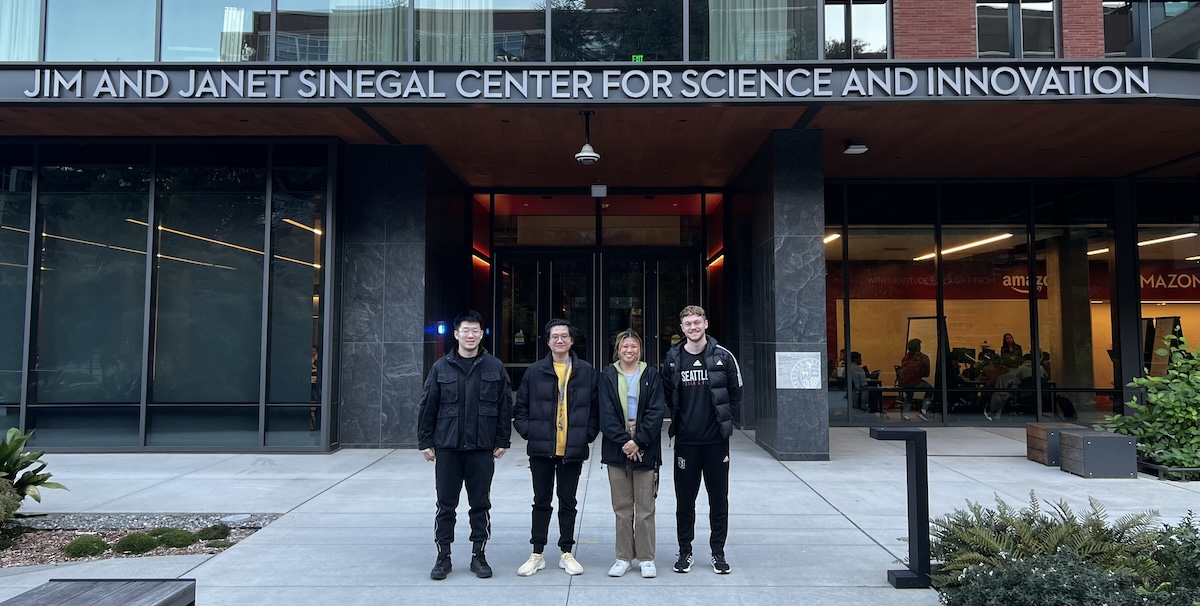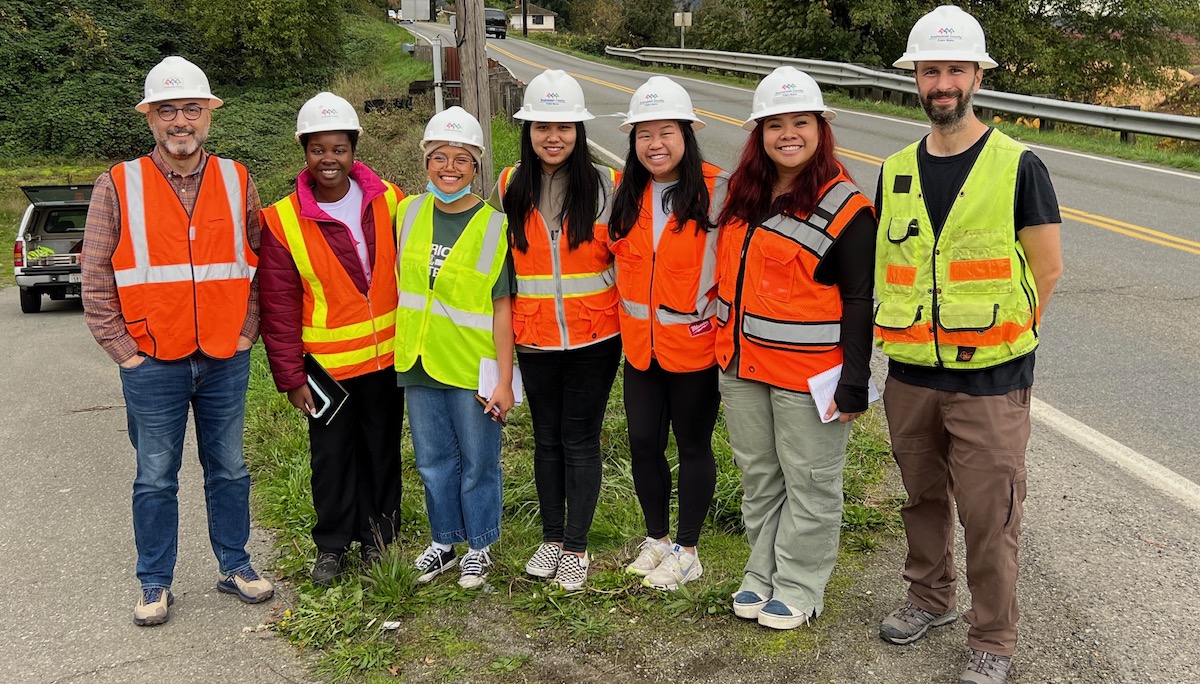Sponsoring Real-World Outcomes
Written by Andrew Binion and Tina Potterf
Friday, May 31, 2024
/44x0:1086x665/prod01/channel_34/media/newsroom/80D7BE37-4D21-41B0-BBBA-799B7C1BE2E2-1130X665.JPG)
The SU team with representatives from their sponsor, Snohomish County.
Project Center pairs students with industry leaders from large companies and nonprofits alike to tackle—and find solutions—to a pressing need.
Through Seattle University’s Project Center, students are truly engineering solutions for real-world problems.
The Project Center hosts Projects Day on campus each year to showcase the culmination of work Seattle University undergraduate students in Engineering, Environmental Science and Computer Science have completed with a project sponsor.
This year students worked on 41 projects from sponsors including T-Mobile, Amazon, Snohomish County, Seattle City Light, F5, Sound Transit and more. The collaboration among the students—with guidance from a faculty advisor—and organizations provides hands-on experience on projects that apply classroom learning to real-life scenarios, while shaping the next generation of STEM professionals.
And the results were showcased at the 37th annual Projects Day on May 31.
“Projects Day showcases our students' innovative solutions to real-world industry challenges through experiential learning opportunities made possible by our invaluable sponsors,” says Rachael Brown, director of the Project Center.
Here’s a look at three projects: Snohomish County, Future Arts and Revere XR.
••
Sponsor: Snohomish County
Student Team: Chelsea Chey, Charline Jean Pierre, Julia Francesca Bornilla, Lora Parrilla, Molly Foote
Faculty advisor: Güven Kiymaz, PhD
Project Scope: The existing Cattle Pass Bridge #183 is a grade separation structure and does not appear to cross over a waterway. The bridge is expected to have extensive maintenance soon and Snohomish County is interested in bridge replacement alternatives that may reduce costs or need for future repairs. For this project, the Seattle University team was tasked with developing a design report, which will be used as the basis for future project planning.
By Tina Potterf
Snohomish County has a long history—reaching back to 2007—working with Seattle University students through the Project Center. This impactful partnership has involved 16 different projects with many focused on transportation initiatives, including bridge replacements, culverts and intersection improvements, explains Tim Tipton, Bridge Engineer for Snohomish County, again a sponsor for one of this year’s projects.
The latest project involved a Type, Size and Location Report for the replacement of Cattle Pass Bridge #183 on Lowell-Larimer Road between Everett and Cathcart. “This report is crucial for potential bridge replacement, a key element in our county's road network,” says Tipton.
Civil engineering major and team member Molly Foote, ’24, describes the task this way: “Our project was to evaluate an existing bridge in Snohomish County and develop alternatives to replace it in the future. Part of the design is to not only develop the alternative but to consider environmental impacts, drainage, and how it will fit in with the surrounding area.”
For Tipton, this is his third time leading a project for the county and says collaborating with the students is always enriching and rewarding. “Each group has been a joy to collaborate with. They ask insightful questions and challenge us to rethink project fundamentals,” he says. “This team, in particular, has been exceptionally professional and thoughtful in their engineering decisions.”
Charline Jean Pierre, ’24, reflecting on working with Snohomish, emphasizes the practical impact of their efforts: “This project isn't just theoretical—it's about making a tangible difference in our community,” says the civil engineering student.
Team member Julia Francesca Bornilla, ’24, a civil engineering major, says being able to be hands-on with a real-world project—and apply lessons from class to something with a tangible result—is her favorite part of the experience. And being part of a team is also gratifying.
“Working as a member of this team has been both an enlightening and fulfilling journey. I think I have learned a lot about myself and how to better my collaboration with others to work more efficiently,” she says. “I think it has been fulfilling in the sense that I have been able to see how capable we all are and how the lessons and skills we have learned and developed are being used.”
As the project progressed, Chelsea Chey, ’24, found joy in the collaborative problem-solving process: “We’ve all grown together, learning from each other’s strengths and weaknesses,” says the civil engineer major. “Being part of Projects Day allows us to showcase our design to the broader Seattle University community and to share insight, receiving feedback and highlighting the significance of the project.”
The Snohomish County team and sponsors.
Identifying solutions—and coming up with a deliverable result—offers invaluable insights into what it’s like working in a professional setting. It’s also a way for students to apply critical thinking to problem solving.
“This project presents a large scope with a lot of design considerations, so it’s been a learning curve recognizing the gaps in our knowledge and finding resources,” says Lora Parrilla, ’24, also a civil engineering major. “I think it makes this experience really rewarding despite the challenges because we get to work on every aspect of the project and fill in those gaps in our knowledge.”
The partnership between students and sponsors also involves a mentorship element, something that Foote found meaningful.
“My favorite part of this experience has been the mentorship from our sponsors, faculty, industry professionals and alumni. Throughout the year, we have gotten feedback on our work and presentation, heard from them during panels and had the opportunity to network,” she says. “Besides receiving technical feedback and support, people have also shared stories from various parts of their career and I found that really inspiring.”
When asked about the most rewarding aspect of sponsoring these projects, Tipton spoke on witnessing student growth. “It’s incredibly fulfilling to see these young engineers develop and gain confidence throughout the year,” he says. “Supporting the next generation of engineering talent and contributing to our community's future improvement is truly gratifying.”
Encouraging other organizations to engage with the Project Center, Tipton emphasizes the mutual benefits.
“I would urge any organization with resources to collaborate with SU. The tangible work produced by students directly benefits sponsors, while mentorship opportunities shape the future of our industry,” he says. “It’s a win-win for all involved.”
••
Sponsor: Future Arts
Student Team: Campbell Stewart, Paola Medina, Alexander Chen and Jennifer Tran
Faculty Advisor: Muneeba Jilani, PhD
Project Scope: The Future Arts Nest (FAN) project will develop an artificial intelligence-driven database of new media artist profiles using cloud technology and machine learning protocols.
By Tina Potterf
Future Arts consists of a team of women cultivating cross-pollination between technology, nature and the arts, with a vision to create more inclusive communities through immersive experiences that challenge known structures.
This is the first year Future Arts has embarked on partnering with the Project Center to tackle a project that is ambitious and forward-thinking, with the student team tasked with transforming Future Arts’ static, manual-input artist database into a sophisticated system powered by machine learning. So that “in turn, we can focus on our mission of serving artists who work with technology to create beautiful and much needed empathy-based innovations,” says Future Arts founder Yuliya Bruk.
This work is pivotal for Future Arts, allowing the organization to focus more on supporting artists rather than on data management. Working with students—and witnessing their passion and work ethic—has been inspiring, says Bruk.
“They have brought such positive energy and excitement to our unique project,” says Bruk, adding that “the students have new ideas, fresh perspectives on what is important to them and have been a wonderful help in not only creating the actual tools, but a sturdy and cross-generational support for the design of these tools.”
Computer science major Paola Medina, ’24, explains the team’s objective: “We were given the task of reducing manual labor for Future Arts by automating data storage and categorization.” And, adds team member Jennifer Tran, “to develop a solution that automates data entry, allowing Future Arts to focus on their core mission of merging STEM with art.”
Along with Medina and Tran, the student team making this work possible includes Campbell Stewart and Alexander Chen—all 2024 graduates of computer science.
For Stewart, ’24, the favorite part of this experience “is seeing the project come to fruition. In the beginning, everything seemed so daunting. It is really rewarding to see our team’s hard work pay off!”
Reflecting on their team dynamic, Medina notes the support they found in each other during stressful times and Chen praises their inclusivity and like-mindedness, with each member bringing their individual perspective to the project.

The Future Arts group and sponsors.
While this project solves a current need for Future Arts, Bruk sees enduring impacts.
“We are grateful to be building this tool in a holistic, empathy-centered way that gives voice and empowerment to the generation that will be most inspired by this work,” says Bruk. “Seeing students come up with solutions that fuse technology with meaningful use-cases that will affect lives of artists and in turn, the future of innovation, has been a rewarding experience that has inspired us to continue building our nonprofit organization.”
With commencement around the corner, the students are in agreement of the positive takeaways from working on a real-world project with a sponsoring organization and how the skills they gained can be beneficial for their professional pursuits.
“I feel much more confident in my problem-solving and research abilities, which I know will be some of the most valuable tools that I will be utilizing in my future career,” says Stewart.
“Overall, being part of Projects Day has provided me with invaluable preparation for my future career. It has offered me a supportive environment to work on real-world projects, allowing me to practice and refine my skills in problem-solving, teamwork and professional communication,” says Tran. “Through engaging with sponsors, attending events and collaborating with my teammates, I’ve gained insights into the importance of collaboration and learned how to effectively contribute to a team effort.”
••
Sponsor: Revere XR
Student Team: Sebastian Law, Haochen Lian, Viet Pham, Lilyana Zoske
Faculty Advisor: Braxton Cuneo
Project Scope: Create a virtual 3D walkthrough mural tour of public art in Seattle by physically documenting the murals and building the virtual environment.
By Andrew Binion
When Yolanda Barton returned to her hometown of Seattle she was stunned by the change she saw, especially in the historically Black community in the Central District.
“Wait, this feels like the Twilight Zone,” says Barton, CEO and founder of Revere XR, recalling the moment she arrived in town with her children after living in Texas. “I don't even know where I am.”
The city she and generations of her family knew and loved was almost unrecognizable and especially profound was the sense of loss of Seattle’s cultural heritage. Long gone were the small clubs where world famous musical acts cut their teeth before performing for stadiums.
Barton knew she had her work cut out for her. That’s when she began partnering with Seattle University computer science students working on their capstone project through the Project Center, tasking them with using virtual reality, augmented reality and artificial intelligence to not only preserve art and murals in Seattle, which can fade and be painted over, but also give the world outside of the Puget Sound instant and enduring access to ephemeral artwork.

The Revere XR team.
“The students really loved that idea and wanted to focus on that,” says Barton. “So that's what they're doing is they're focusing on collecting art murals, images and locations and then creating this immersive space that allows you to see it and experience it.”
The final product would be accessible online and people everywhere will be able to experience it by using virtual reality headsets.
Computer science major Sebastian Law, ‘24, served as project manager for the effort, leading the documenting of murals and implementing them into the VR environment. He says Barton gave the team a lot of creative freedom.
“The project was presented to us in a pretty open-ended manner,” says Law, who plans to return next year to complete his fifth year of eligibility on the SU Track and Field team. After that he plans to pursue a PhD in interdisciplinary research of biomedical devices and computer science, specifically researching advanced prosthetics. “The main requirement was for us to be able to preserve Seattle’s art history, both past and present, specifically highlighting Seattle’s murals, but the way we did this was up to us.”
Law’s favorite part of the project was mural and art tours through the Central District with local artist Melvin Freeman, known as The Fly Blind Guy, a visual artist who is losing his vision and is working to tell his story as a local artist.
“Melvin is the key artist we are highlighting in our VR experience by showcasing his work and story,” Law says. “Learning more about where he came from and what it was like growing up in the Central District has been amazing.”
For companies and organizations that might consider working with SU students at the Project Center, Barton offers this advice:
“You're not just sponsoring a project or handing them work that you and your company don't feel like doing or introducing them to your industry,” Barton says. “You're igniting the future leaders and innovators and giving them an opportunity to apply their ideas, concepts, enthusiasm, energy into the future of the workforce.”
This is Part II in a two-part series spotlighting some of this year’s projects for Projects Day. Read Part I.
Written by Andrew Binion and Tina Potterf
Friday, May 31, 2024

/61x0:1070x637/prod01/channel_34/media/seattle-university/news-amp-stories/images/Spring-break-UREC-trip-photo-1130X637.png)
/118x0:1013x565/prod01/channel_34/media/seattle-university/news-amp-stories/images/US-News-aerial-pic-1130X565.jpg)
/115x0:1016x569/prod01/channel_34/media/seattle-university/news-amp-stories/images/Cristo-Ray-signing-use-this-1130X569.jpg)